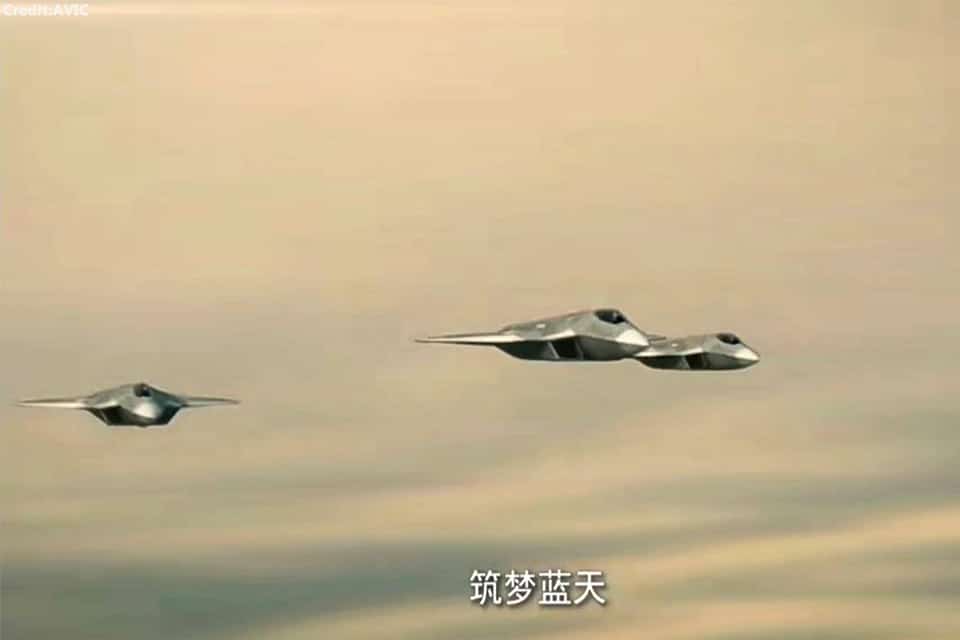Aerospace
Meet China’s 6th-Generation Stealth Fighter jet

China is in the process of developing a sixth-generation fighter aircraft, which could potentially make its debut as early as 2035. This development is poised to significantly alter China’s military strategy and reshape the landscape of aerial warfare.
The upcoming sixth-generation fighter (J-25 or J-28) will stand out for its greater speed, higher operational altitude, and improved radar stealth capabilities. These characteristics will help the aircraft succeed in ground attack and fast penetrating air missions.
One striking aspect of China’s upcoming sixth-generation stealth fighter is its apparent similarity to the Next Generation Air Dominance (NGAD) stealth aircraft being developed by the United States: a tailless design. This innovative approach marks a departure from conventional aircraft configurations.
The Aviation Industry Corporation of China (AVIC) has unveiled a video featuring CGI concept art of this futuristic stealth fighter. The depicted twin-engine jet fighters exhibit distinctive low-reflective diamond-shaped wings, reminiscent of Northrop Grumman’s YF-23 Black Widow demonstrator fighter. Moreover, these aircraft feature a blended-wing body configuration and notably lack a traditional tail structure.
This finless, tailless aircraft is referred to as a “blended wing-body design.” This arrangement has various advantages, including the capacity to generate more lift, attain longer operational ranges, and consume less fuel. The greatest significant gain, though, is most likely its greater stealth capabilities.
Traditional vertical structures, such as tails and fins, which help with speed, maneuverability, and vectoring, also increase the radar return signature available to against air defenses. The absence of these features enhances the aircraft’s stealth, making it more challenging for adversaries to detect and track.
It is crucial to bear in mind that the artwork and mockups presented at this stage should be interpreted with caution. Many conceptual designs never progress to production and those that do invariably undergo significant revisions.
The precise capabilities of a sixth-generation fighter are unknown, but it is widely expected to outperform its predecessors in a variety of ways. This includes more powerful armament systems, enhanced stealth technologies, artificial intelligence integration, and a variety of other high-end capabilities that will position it as a formidable asset in future air warfare scenarios.
The J-20 of China is now being upgraded to close the gap between it and the F-22 and F-35 of the US. The design includes many elements that have been “copied from the F-22 and F-35, including nose cone shaping, the electro-optical targeting system (EOTS) under the nose, and the side-mounted [diverter less supersonic inlet] intakes,” according to a report.
As a result, the United States, refusal to share much about its sixth-generation jet, could be related to concerns about other countries, “stealing” the design and technical data. An understanding of exterior structures may provide some insight, into the next generation of fighters.

Aerospace
When Ratan Tata was denied entry to the airfield at the Aero India show, he waited

During our visit to Aero India 2019, we had the unexpected opportunity to see Ratan Tata at the event, which was a thrilling moment for us. However, there was a surprising hiccup when the security staff didn’t allow him to enter due to a lack of a security pass.
Despite this, he remained calm and patiently waited for about 20 minutes until a member of the Tata team brought him the required pass, after which he calmly proceeded inside. It was a humbling sight, showcasing his composed demeanor even in such situations.
Ratan Tata ji is not only a renowned industrialist but also a trained pilot, holding a pilot’s license. In 2007, he became the first Indian civilian to fly the F-16 Falcon during the Aero India show in Bangalore—a proud moment for the nation.
His passion for aviation extended beyond flying, as he played a key role in shaping India’s aerospace industry. Under his leadership, Tata ventured into manufacturing and maintaining aerospace components while upholding its legacy of quality. Notably, Tata’s collaboration with Airbus to develop and manufacture the C295 aircraft is a testament to its growing influence in the sector.
-

 Aviation2 months ago
Aviation2 months agoMicrosoft Flight Simulator Raises $3 Million to Bring Back the An-225 Mriya
-

 Airlines2 months ago
Airlines2 months agoQantas Engineers Stage Walkout Over Cost of Living Concerns
-

 Airlines2 months ago
Airlines2 months agoQatar Citizens Can Travel to the United States Without a Visa
-

 Aviation2 months ago
Aviation2 months agoQatar Airways bans these new Electronic Devices on plane
-

 Airlines2 months ago
Airlines2 months agoJapan Airlines Rolls Out Free Domestic Flights to International Passengers
-

 Defence2 months ago
Defence2 months agoWhich Country Has the Largest Fleet of Fighter Aircraft?
-

 Airport2 months ago
Airport2 months agoWestern Sydney Airport Welcomes Its First Plane After 6 Years of construction
-

 Aviation2 months ago
Aviation2 months agoDid you know ? Once Boeing 747 carried 1088 passenger in 1991








